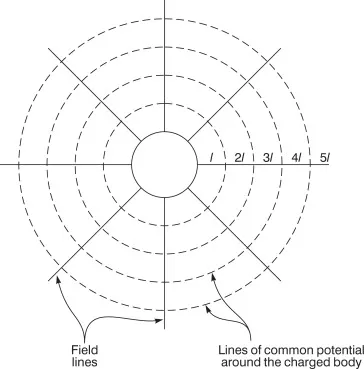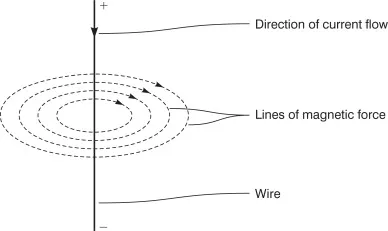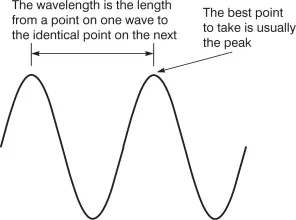![]()
Chapter 1. Radio Waves and Propagation
So, let’s begin at the beginning. This chapter provides a basic understanding of radio waves, electric fields, and propagation. It also covers the basic formula for the relationship between frequency and wavelength. The bulk of this chapter is a great primer on how radio waves travel in real-world applications, including reflection and multipath, as well as containing quite a number of engaging sections on atmospheric effects.—Janine Sullivan Love
The properties of radio waves and the way in which they travel or propagate are of prime importance in the study of radio technology. These waves can travel over vast distances enabling communication to be made where no other means is possible. Using them, communication can be established over distances ranging from a few meters to many thousands of miles. This enables telephone conversations and many other forms of communication to be made with people on the other side of the world using shortwave propagation or satellites. Radio waves can be received over even greater distances. Radio telescopes pick up minute signals from sources many light years away.
Radio waves are a form of radiation known as electromagnetic waves. As they contain both electric and magnetic elements it is first necessary to take a look at these fields before looking at the electromagnetic wave itself.
1.1. Electric Fields
Any electrically charged object, whether it has a static charge or is carrying a current, has an electric field associated with it. It is a commonly known fact that like charges repel one another and opposite charges attract. This can be demonstrated in a number of ways. Hair often tends to stand up after it has been brushed or combed. The brushing action generates an electrostatic charge on the hairs, and as they all have the same type of charge they tend to repel one another and stand up. In this way it can be seen that a force is exerted between them. Examples like these are quite dramatic and result because the voltages that are involved are very high and can typically be many kilovolts. However, even the comparatively low voltages that are found in electronic circuits exhibit the same effects, although to a much smaller degree.
The electric field radiates out from any item with an electric potential as shown in Figure 1.1. The electrostatic potential falls away as the distance from the object is increased. Take the example of a charged sphere with a potential of 10 volts. At the surface of the sphere the electrostatic potential is 10 volts. However, as the distance from the sphere is increased, this potential starts to fall. It can be seen that it is possible to draw lines of equal potential around the sphere as shown in Figure 1.1.
Figure 1.1. Field lines and potential lines around a charged sphere
The potential falls away as the distance is increased from the sphere. It can be shown that the potential falls away as the inverse of the distance, i.e., doubling the distance halves the potential. The variation of potential with the distance from the sphere is shown in Figure 1.2.
Figure 1.2. Variation of potential with distance from the charged sphere
The electric field gives the direction and magnitude of the force on a charged object. The field intensity is the negative value of the slope in Figure 1.2. The slope of a curve plotted on a graph is the rate of change of a variable. In this case it represents the rate of change of the potential with distance at a particular point. This is known as the potential gradient. It is found that the potential gradient varies as the inverse square of the distance. In other words doubling the distance reduces the potential gradient by a factor of four.
1.2. Magnetic Fields
Magnetic fields are also important. Like electric charges, magnets attract and repel one another. Analogous to the positive and negative charges, magnets have two types of pole, namely a north and a south pole. Like poles repel and dissimilar ones attract. In the case of magnets it is also found that the magnetic field strength falls away as the inverse square of the distance.
While the first magnets to be used were permanent magnets, much later it was found that an electric current flowing in a conductor generated a magnetic field (Figure 1.3). This could be detected by the fact that a compass needle placed close to the conductor would deflect. The lines of force are in a particular direction around the wire as shown. An easy method of determining which way they go around the conductor is to use the corkscrew rule. Imagine a right-handed corkscrew being driven into a cork on the direction of the current flow. The lines of force will be in the direction of rotation of the corkscrew.
Figure 1.3. Lines of magnetic force around a current-carrying conductor
1.3. Radio Waves
As already mentioned radio signals are a form of electromagnetic wave. They consist of the same basic type of radiation as light, ultraviolet and infrared rays, differing from them in their wavelength and frequency. These waves are quite complicated in their make-up, having both electric and magnetic components that are inseparable. The planes of these fields are at right angles to one another and to the direction of motion of the wave. These waves can be visualized as shown in Figure 1.4.
Figure 1.4. An electromagnetic wave
The electric field results from the voltage changes occurring in the antenna which is radiating the signal, and the magnetic field changes result from the current flow. It is also found that the lines of force in the electric field run along the same axis as the antenna, but spreading out as they move away from it. This electric field is measured in terms of the change of potential over a given distance, e.g., volts per meter, and this is known as the field strength.
There are a number of properties of a wave. The first is its wavelength. This is the distance between a point on one wave to the identical point on the next, as shown in Figure 1.5. One of the most obvious points to choose is the peak, as this can be easily identified, although any point is acceptable.
Figure 1.5. The wavelength of an electromagnetic wave
The second property of the electromagnetic wave is its frequency. This is the number of times a particular point on the wave moves up and down in a given time (normally a second). The unit of frequency is the hertz and it is equal to one cycle per second. This unit is named after the German scientist who discovered radio waves. The frequencies used in radio are usually very high. Accordingly the prefixes kilo-, mega-, and giga- are often seen; 1 kHz is 1000 hertz, 1 MHz is a million hertz, and 1 GHz is a thousand million hertz, i.e., 1000 MHz. Originally the unit of frequency was not given a name and cycles per second (c/s) were used. Some older books may show these units together with their prefixeskc/s, Mc/s, etc. for higher frequencies.
The third major property of the wave is its velocity. Radio waves travel at the same speed as light. For most practical purposes the speed is taken to be 300,000,000 meters per second, although a more exact value is 299,792,500 meters per second.
1.4. Frequency to Wavelength Conversion
Many years ago the position of stations on the radio dial was given in terms of wavelengths. A station might have had a wavelength of 1500 meters. Today stations give out their frequency because nowadays this is far easier to measure. A frequency counter can be used to measure this very accurately, and with today’s technology their cost is relatively low. It is very easy to relate the frequency and wavelength as they are linked by the speed of light as shown:
where λ = the wavelength in meters
f = frequency in hertz
c = speed of radio waves (light) taken as 300,000,000 meters per second for all practical purposes
Taking the previous example the wavelength of 1500 meters corresponds to a frequency of 300,000,000/1500 or 200 thousand hertz (200 kHz).
1.5. Radio Spectrum
Electromagnetic waves have a wide variety of frequencies. Radio signals have the lowest frequency, and hence the longest wavelengths. Above the radio spectrum, other forms of radiation can be found. These include infrared radia...






